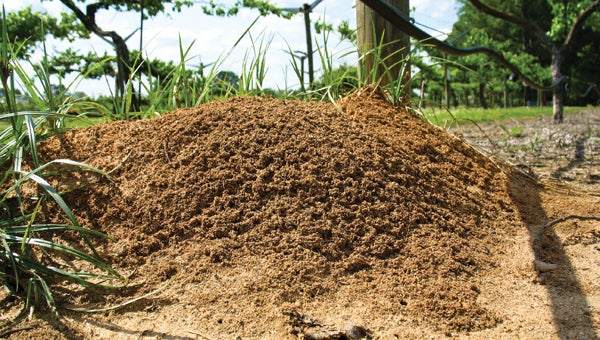
By Joshua Elmore
In the early 1900s, Solenopsis richteri Forel and Solenopsis invicta Buren and their families came to visit a port city on the Alabama Gulf Coast known as Mobile.
S. richteri traveled around and decided to stay in Northeastern Mississippi, Northwestern Alabama and Southern Tennessee.
However, S. invicta trekked extensively throughout Alabama as well as touring the rest of the Southeast, Texas, Oklahoma, California and Puerto Rico.
S. richteri and S. invicta were a social lot and dotted the landscape with their homes.
Commonly known as imported fire ants, S. richteri and S. invicta are insects that Alabamians have to deal with. These invasive species have affected Alabama homes, farms, and schools. In most locales, Solenopsis richteri and Solenopsis invicta are loathed, cursed, and much despised primarily due to their housing and the problems they cause.
Mounds are the quintessential signal of fire ant settlement although the mound is not essential for the colonies survival. The ants use mounds to regulate temperature and moisture in the colony and frequently pop up in response to cooler weather and/or heavy rains. Mounds serve as an above ground nursery providing optimal conditions in both temperature and moisture to rear a brood. Workers move the larvae, pupae, and queen(s) around the tunnels of the mound to keep them in the finest conditions. On sunny winter days, the workers will move the brood to the warm upper portions of the mound. When it is extremely hot or cold, fire ants will move deep into the ground for protection. Mounds that suddenly appear to pop up are from colonies that have been living underground for some time. Mounds may also appear because the ants are cleaning out tunnels or preparing for a mating flight of reproductive ants.
Mating flights most frequently occur in spring and fall after a rain event, but will often take place whenever the temperature is between 75-91?F, humidity is 80% or higher, and the wind is low. The newly mated queen lands, drops her wings and excavates a nest and seals herself into a small cell like room a few inches deep in the ground. This is the start of a new fire ant colony.
The first workers emerge about a month after nesting. Gathering food, protecting the nest, tending to the brood and continual nest construction fills most of the workers time. The workers begin to tunnel into the surrounding soil making many interconnected chambers. The soil removed during the formation of the chambers and tunnels is carried above ground where it is used to form additional chambers and tunnels.
The queen focuses on egg production (around 1000 eggs/day). The workers vary in size from small to large. Around ninety days, the colony is composed of primarily smaller workers and a few large workers. Approximately 200 days after starting the nest, some reproductive ants will begin to appear in the colony. The colony is well developed containing 6,500-14,000 workers, with around 3% large workers. The colony continues to grow and increase in size usually reaching maturity in 2-3 years. At maturity, the mound may house 100,000 or more workers and measure 12 to 15 inches wide and about 10 inches tall. The mounds size and shape will differ based on the soil type.
The surface of a fire ant mound usually has a protective crust, while the inside of the mound is filled with tunnels and chambers. The chambers form a cone that extends 1 to 3 feet into the ground. Some of the tunnels may extend downward 5 or more feet, depending on the depth of the water table. Most of the mounds do not have a visible entrance or exit except during mating flights. During these mating flights the workers will expose many holes on top of the mound. After the flights, the holes are promptly sealed.
Despite multiple assassination attempts on their queen(s), these creatures endeavor to persevere. Elimination efforts are usually broad spectrum not surgical in nature. Fire ants cannot be eradicated entirely because it is not possible to treat all infested areas. There is no one best method for fire ant control, especially in large areas. Your objective should be to find the method or methods that are most cost-effective, environmentally sound, and fit your tolerance level for fire ants.
Two resources providing effective imported fire ant management options are The Alabama Cooperative Extension System www.aces.edu/dept/fireants and the National eXtension Initiative www.extension.org/fire+ants. These resources will help you choose an approach fire ant control that is right for you.
For more information call the Chilton County Extension office 205-280-6268.
Joshua Elmore is a Regional Extension Agent in Livestock and Forages for Alabama Cooperative Extension.
